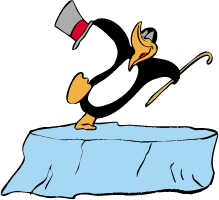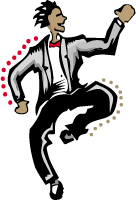

This book offers advice gleaned from about nine years of experience in ballroom dancing and collecting ballroom dance music. My comments will reflect the social dance scene in the San Francisco Bay Area; elsewhere, your mileage may vary.
There are two styles of competitive ballroom dancing: the "International" style, which is danced worldwide, and the "American" style, which, as you might guess, is practiced mostly here in the United States. Competitions in International-style dancing will include the five "Standard" (a.k.a. "Modern," a.k.a. "Ballroom") dances--Waltz, Foxtrot, Tango, Viennese Waltz, and Quickstep--and the five "Latin" dances: Cha Cha, Rumba, Samba, Paso Doble, and Jive. American-style competitions feature four "Smooth" dances--Waltz, Foxtrot, Tango, and Viennese Waltz--and five "Rhythm" dances: Cha Cha, Rumba, Mambo, Bolero, and East Coast Swing. Thus Smooth corresponds approximately to Standard, and Rhythm to Latin.
In the Bay Area, most social ballroom dancers learn American and/or International versions of the above dances, although Paso Doble is rarely seen outside of competitions. Several "Club" dances are also popular, including West Coast Swing, Hustle, Salsa, Nightclub Two Step, Lindy Hop, and Argentine Tango. (Club--short for "Nightclub"--is just a label applied by ballroom dancers to partner dances performed in neither American-style nor International-style ballroom competitions.) Outside California, Nightclub Two Step is also known as the California Two Step; it is not related to the Country Two Step.
 I
will use the term "ballroom dancing" broadly to include American-style,
International-style, and Club dances: that is, Waltz, Foxtrot, Tango, Viennese
Waltz, Quickstep, Cha Cha, Rumba, Samba, Paso Doble, Jive, East Coast Swing,
Bolero, Mambo, Salsa, Hustle, West Coast Swing, Nightclub Two Step, Argentine
Tango and Lindy Hop. Ballroom dancers also do some Polka and Merengue, but,
like Paso Doble, they are almost never played at social ballroom dance parties
in this area.
I
will use the term "ballroom dancing" broadly to include American-style,
International-style, and Club dances: that is, Waltz, Foxtrot, Tango, Viennese
Waltz, Quickstep, Cha Cha, Rumba, Samba, Paso Doble, Jive, East Coast Swing,
Bolero, Mambo, Salsa, Hustle, West Coast Swing, Nightclub Two Step, Argentine
Tango and Lindy Hop. Ballroom dancers also do some Polka and Merengue, but,
like Paso Doble, they are almost never played at social ballroom dance parties
in this area.
A pair of concise and well-documented articles by Don Herbison-Evans describe the origins of today's ballroom dances. His History of Modern Ballroom Dancing and History of Latin-American Dancing are both available on the internet.